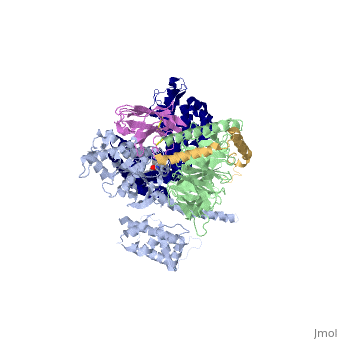Beta2 adrenergic receptor-Gs protein complex
From Proteopedia
(Difference between revisions)
| Line 2: | Line 2: | ||
<StructureSection load='3sn6' size='340' side='right' caption='[[3sn6]], [[Resolution|resolution]] 3.20Å' scene=''> | <StructureSection load='3sn6' size='340' side='right' caption='[[3sn6]], [[Resolution|resolution]] 3.20Å' scene=''> | ||
==Introduction== | ==Introduction== | ||
| - | [[G protein-coupled receptors]] (GPCRs) are a large family of protein receptors which have seven-transmembrane helices and are found over a large array on eukaryotic cells. These receptors take major part in a multitude of signal transduction pathways, including amongst others responses to hormones and neurotransmitters, sensing light, taste and smell, | + | [[G protein-coupled receptors]] (GPCRs) are a large family of protein receptors which have seven-transmembrane helices and are found over a large array on eukaryotic cells. These receptors take major part in a multitude of signal transduction pathways, including amongst others responses to hormones and neurotransmitters, sensing light, taste and smell, as well as many others. These receptors are also involved in many different types of diseases and are the target of almost 50% of current medical drugs. |
The [[Beta-2 Adrenergic Receptors]] are a type of GPCRs which are activated by catecholamine hormone ligands such as adrenaline (epinephrine). These receptors are responsible for many of the adrenaline related (“fight-or-flight”) responses and functions, and are used as a common model system for the GPCR family. | The [[Beta-2 Adrenergic Receptors]] are a type of GPCRs which are activated by catecholamine hormone ligands such as adrenaline (epinephrine). These receptors are responsible for many of the adrenaline related (“fight-or-flight”) responses and functions, and are used as a common model system for the GPCR family. | ||
GPCRs bind their ligand and [[Group:SMART:A Physical Model of the β2-Adrenergic Receptor|overcome a conformational change]] which allows a [[Guanine nucleotide-binding protein]] (G protein) to detach from the cellular end of the receptor and start the different signal transduction pathways. | GPCRs bind their ligand and [[Group:SMART:A Physical Model of the β2-Adrenergic Receptor|overcome a conformational change]] which allows a [[Guanine nucleotide-binding protein]] (G protein) to detach from the cellular end of the receptor and start the different signal transduction pathways. | ||
Revision as of 19:00, 3 June 2015
Beta2 adrenergic receptor-Gs protein complex
| |||||||||||
References
- ↑ Rasmussen SG, DeVree BT, Zou Y, Kruse AC, Chung KY, Kobilka TS, Thian FS, Chae PS, Pardon E, Calinski D, Mathiesen JM, Shah ST, Lyons JA, Caffrey M, Gellman SH, Steyaert J, Skiniotis G, Weis WI, Sunahara RK, Kobilka BK. Crystal structure of the beta2 adrenergic receptor-Gs protein complex. Nature. 2011 Jul 19;477(7366):549-55. doi: 10.1038/nature10361. PMID:21772288 doi:10.1038/nature10361
Proteopedia Page Contributors and Editors (what is this?)
Dan Elran, Michal Harel, Alexander Berchansky, Joel L. Sussman

